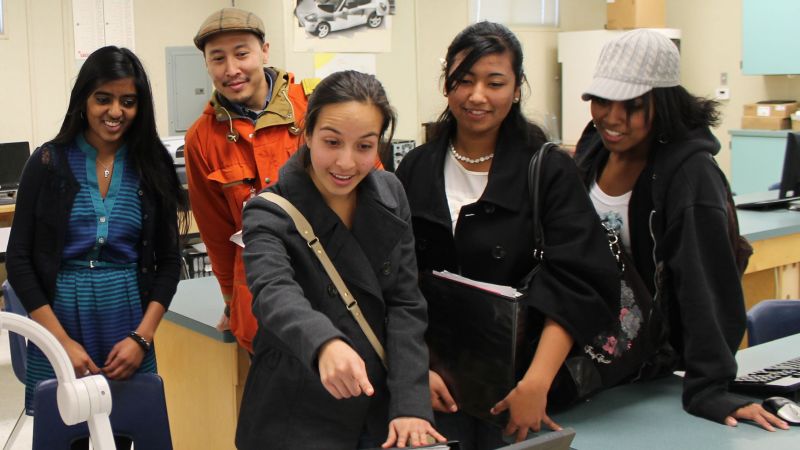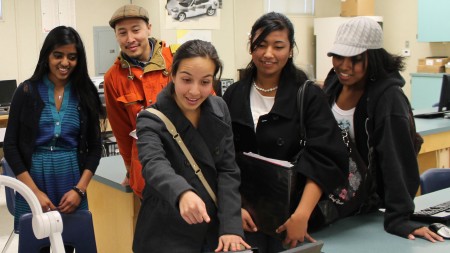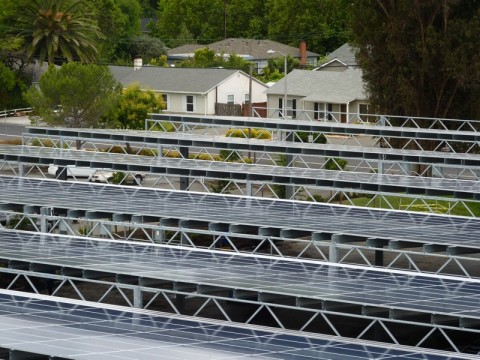Who Gets the Cash for Energy Upgrades from Prop 39?

Who Gets the Cash for Energy Upgrades from Prop 39?

President Obama raised eyebrows earlier this month by elevating climate change to a top national priority in his inaugural address.
California has long been a policy leader on the issue. In the last election, voters overwhelmingly passed Proposition 39, which closed a corporate tax loophole and uses the cash to create the largest energy-efficiency initiative of any state.
The proposition requires the money be spent on public buildings, however the details have been left to lawmakers. Now there’s the predictable debate over who will get the money and how it might be spent.
Can I audit this class?
Tour Livermore High School with some students from the Green Engineering Academy and you’ll hear plenty of suggestions for energy efficiency upgrades at their school.
“What would be nice is if they had skylights,” says senior Natasha Moore. “So more natural lighting can come in.”
Senior Laila Hassen says the benefits go beyond cost savings.
“They've shown that when students are under hours of fluorescent lighting they can’t concentrate as well” she says. “It can actually hurt their eyes.”
Moore and Hassen are part of the Leadership in Energy Efficiency Program, or LEEP. The program is funded by Pacific Gas & Electric Corp. and administered by the Alameda County of Education. These students completed a district-wide energy audit with the help of an engineering firm, saving the school thousands of dollars.
On tour, the students point out a new motion sensor attached to an old snack machine, that keeps the lights and cooler from running idly. But the students want to do better. They want the latest energy efficient machine.
Junior Priya Sri-Tharan says it would almost pay for itself the first year with $2,000 in energy savings.
“If you turn down the little stuff,” says Sri-Thran. “It’s going to eventually add up.”
Susan Kinder, the chief business official for Livermore’s school district, agrees.
“We’ve been saving between 15-and-20 percent of our electricity bills already,” says Kinder, “just with the small changes we’ve done so far.”
That’s about $300,000 a year. Kinder says she’d like to do more. But in a tight funding environment where their current energy savings are going to keep basic programs afloat, where does one find the initial investment?
“That is the huge hurdle,” says Kinder.
A billion-dollar windfall
Enter the windfall from Proposition 39, almost single-handedly bankrolled by San Francisco hedge fund billionaire Tom Steyer. California voters approved the November, 2012 initiative by a nearly two-thirds margin.
The measure will raise an estimated $1.1 billion a year from the closed tax loophole. Half will go directly into the state general fund. But for the first five years, the other half will be used to retrofit public schools or public office buildings.
“When you come up with half of a billion in one year,” says Steyer, “a lot of people put out their hand and say, 'I have the exact solution for you.'”
Steyer says one of the goals is to create tens of thousands of construction jobs.
“It would also be an investment,” says Steyer. “So that in spending this money we would save money for the next 25 years because we would have reduced energy bills.”
Altogether, the measure is expected to generate $2.75 billion in new money by 2018 for energy efficiency projects. Experts project the money could fund efficiency upgrades at half of California’s public schools, shaving 20-to-40 percent off their monthly utility bills.

Competing needs
So who should get the grants? Governor Jerry Brown’s proposed budget has it spread around all public schools. But State Senator Kevin De Leon, a Los Angeles Democrat, has introduced legislation to distribute the money based on need.
“Every school district is different,” says De Leon. “You have some districts that have brand new schools, and within the same district you have schools that are very old, schools that emit a lot of carbon and waste energy."
Take Fremont High. The Alameda County school is slated for a rebuild. On a recent visit here, the school had been dealing with a broken boiler line. Space heaters dotted the hallways.
Just across the county, Albany High School stands in contrast. Eight years ago the district worked to do basic school retrofits like lighting, as well as investing in a technology uniquely suited for their high school: a co-generator. It creates electricity for the school while producing heat for the two pools.
Albany Unified Superintendent Marla Stephenson says the carefully tailored investment paid off and the district has, “saved at least $100,000 a year.”
“It started with cost,” says Stephenson, “and it’s now moved to what’s good for the environment and global warming.”
Yvonne Tom oversees energy efficiency programs for the Alameda County Office of Education. She says in her years working on a variety of campuses, she's learned a few lessons she would pass on to lawmakers.
“We need really good quality audits done by a real engineering firm,” says Tom, “who has not a vested interest in selling you a particular product.”
Tom advocates spending some of the Prop 39 money to hire experts at a county level to help districts make the best use of funds.
Others advocate spending on “the low hanging fruit,” basic energy efficiency upgrades, like new windows and lighting. Senator De Leon says these provide the most savings for the least cost.
Adam Browning, with the non-profit group Vote Solar, argues for renewable energy systems like solar panels. Browning says the ballot measure explicitly included clean energy solutions in its language and that should guide implementation. Anything else, he says, “reeks of a bait and switch.”
“They didn’t just show pictures of compact fluorescents,” says Browning. “There were plenty of solar panels that were used to sell this and voters expressed their preference for something. They had it before them. That should be honored.”
The state Legislature is expected to pass a plan to distribute the money later this summer.
